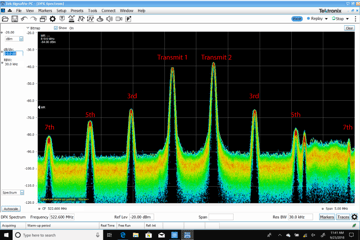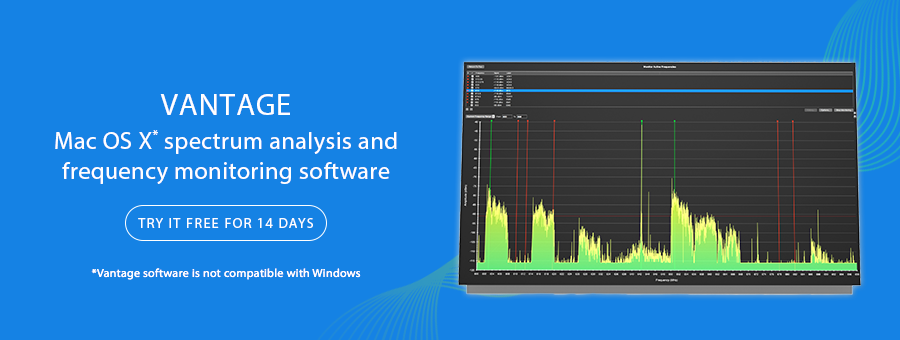Today, RF environments are more crowded than ever. With the further loss of 84 MHz in the UHF band and the introduction of new white space devices, wireless audio spectrum is looking more packed everyday.
When you’re installing or running a wireless mic or IEM system, it’s your job to ensure the sound quality is absolutely perfect. This means doing everything in your power to prevent interference and signal dropouts by coordinating frequencies to accommodate local RF conditions. While this can be achieved through good antenna placement and system design, success is also highly dependent on good frequency coordination and having a solid band plan.
If your clients start complaining about signal dropouts or interference after an install is complete, you could be forced to spend costly labor time fixing mistakes. And anyone who has experienced this in a live environment knows how maddening it can be to troubleshoot during a show.
What is RF coordination?

RF Venue Vantage spectrum monitoring software for Mac OSX showing DTV stations and many narrowband sources
Essentially, wireless frequency coordination is the practice of calculating and selecting frequencies so you can configure your transmitters to be free from interference. Keep in mind that the RF environment is dynamic, so monitoring and updating your coordinated list of frequencies over time and making adjustments is a critical step that most users overlook.
Aside from third party interference sources like television stations or other wireless audio systems, RF noise can come from all kinds of sources. And not only will you need your frequencies to be free from third party sources, but you'll also need to ensure your own transmitters are not creating high level intermod products. For technical details on what intermodulation distortion is and how to avoid it check out a previous post here.

3rd, 5th, and 7th order Intermodulation distortion (IMD) products are shown
RF coordination won’t, for example, save you if one or more strong signals suddenly enter the area. A classic example is at trade shows where best efforts at coordinating a system before a show go sideways when multiple news crews show up with powerful transmitters and interfere with coordinated frequencies. But a good band plan and real time RF monitoring using spectrum analysis will allow you to identify where the problem is and either go to back up frequencies or re-adjust your plan.
Using RF coordination software
Before firing up Shure's Wireless Workbench, Sennheiser's Wireless System Manager, or Professional Wireless Systems' IAS you'll need a list of all known existing frequencies and equipment you'll be dealing with. This includes local UHF television stations and any nearby systems specific to the venue (like their house intercom, assistive listening systems, and other wireless microphones or IEMs). You also need to know about the existence of any third party systems, like an intercom system used by a video crew, lighting systems, or third party media. You need the make, model, quantities, and frequency band of each system. Gathering this information is where most of the legwork is in coordination and the process can be time consuming on large scale events, but it can mean the difference between success and failure. Having a repeatable process in place to do this is how the NFL's elite gameday coordinators are able to operate in crowded stadium environments week after week during the season.
Once you have all the equipment details on hand, you can begin the process of getting them into your RF coordination software of choice and running the calculations to build a list of frequencies free from interference and intermod distortion.
Next, you'll want to start scanning with an RF spectrum analyzer to capture wideband spectrum data to import into your coordination software of choice. There are many on the market including our rack-based RF Explorer RF Explorer RackPRO spectrum analyzer. The following video provides a walkthrough of how our Vantage software can scan and export a compatible CSV file for further process in a coordination tool like Wireless Workbench:
Video walkthrough of using Vantage with Shure's Wireless Workbench coordination software
Finally, use a war-gaming process to make sure your coordination properly accounts for all signals and potential sources of interference. War-gaming is a hands-on procedure that increases the reliability of coordinated wireless frequencies through rigorous testing. It’s a method of testing your frequencies in the real RF environment on the ground so you know what works and what doesn’t, independent of what the coordination software has provided. It’s most often used at big events by professional RF coordinators, but the process is just as applicable to small-scale events and can reveal bad frequencies that otherwise look good on paper. We have a video walkthrough of that process below:
Dennis
Dennis Hammer is a content strategist and writer. He lives in Connecticut with his wife and daughter.
More from the blog

The Top Three Wireless Microphone Problems and How to Solve Them

RF 101: Must-have tools in the RF toolkit

The Importance of RF Coordination
Subscribe to email updates
Stay up-to-date on what's happening at this blog and get additional content about the benefits of subscribing.

